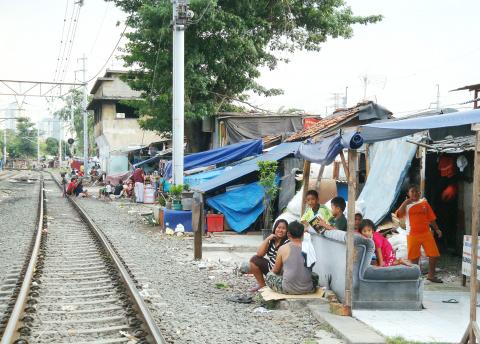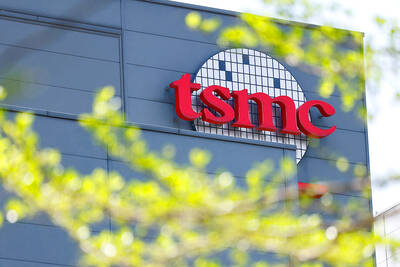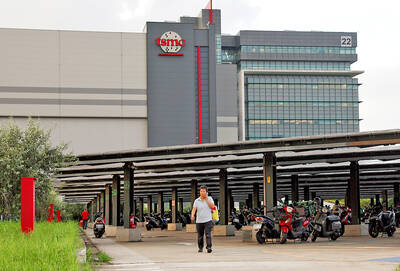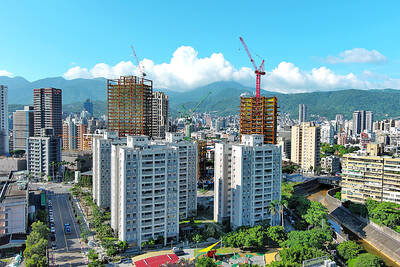“I decided to experience the real Jakarta,” said a tourist, stepping gingerly between puddles of putrid water and a scurrying rat in a scene that would never make a postcard.
Rohaizad Abu Bakar, 28, a bank employee from Singapore, said he could not believe his eyes as he wandered around the slum in the Indonesian capital, a jumble of hundreds of shacks, some less than 1m from a railway line.
Nearby, a small girl picked up a discarded juice bottle in search of a sip while a man wearing tattered shorts lay slumped on a dirty old mattress. Only a blue plastic tarpaulin offered shelter from tropical downpours.

Photo: AFP
So-called “poverty tourism” is on the rise in Jakarta.
Organizers said it raises awareness and brings aid to the destitute of the city, but accusations of exploitation are never far away and critics say poverty should not be a tourist attraction.
A few hundred families cram into the slum in the Tanah Abang neighborhood, minutes from gleaming shopping malls where the likes of Gucci and Louis Vuitton compete to lure the newly minted beneficiaries of Indonesia’s economic miracle.
Abu Bakar opted against the picturesque landscapes of other parts of the country to instead join a “Jakarta Hidden Tours” trip, which aims to show visitors the squalid conditions of the nation’s poor.
“Tourists stay in their ghetto. We show what is really Jakarta,” said Ronny Poluan, 59, an Indonesian documentary maker who created the non-profit organization in 2008.
Recent years have seen “poverty tourism” mushroom globally, from the favelas of Brazil to the slums of Dharavi in Mumbai, India, popularized by the film Slumdog Millionaire.
“We have about 10 tours per month, with two to four tourists each time. More and more people are coming, some now even come just for my tour,” Poluan said.
“I’ve had tourists from as far away as Washington. They are not only backpackers, but also businessmen, bankers,” he added, before being cut short by shouting reverberating around the slum.
“Kereta, Kereta” (“a train, a train”) cried mothers rushing to grab children playing on the track as a roaring locomotive approached, whipping up clouds of dust and garbage as it surged toward the flimsy-looking shacks.
The train recently claimed the life of one little girl who died as she ran after her cat.
The slum dwellers, like half of Indonesia, live on less than US$2 per day. Each tourist pays 500,000 rupiah (US$54) to visit, with half of that going to the tour company and the rest funding doctor visits, microfinance projects or community projects such as school building.
“I don’t give cash. I pay the doctors directly for example,” Poluan said.
However, that does not reassure some critics.
“I’m against slums being turned into tourist spots,” Urban Poor Consortium activist Wardah Hafidz said.
“It’s not about shame. People should not be exhibited like monkeys in a zoo,” she said. “What residents get from these tours, in cash or whatever form, only strips them of their dignity and self respect, turning them into mere beggars.”
“They not only become dependent on handouts, but come to expect them. It doesn’t help them to believe they are capable of standing on their own two feet or getting them out of the spiral of poverty,” she added.
Nonetheless, residents say they look forward to the daily influx of foreigners witnessing their lifestyles.
“I like that foreigners want to know about us. It’s good they want to know about us,” said Djoko, a father in his fifties, as he removed labels from a pile of glass and plastic bottles before selling them for recycling.
Tourists deny voyeurism, instead saying that what they witness inspires them to action.
“If I had not seen it, I would not have done anything about it,” said Caroline Bourget, a teacher at Jakarta’s French school.
She is now discussing setting up a mobile school in the slum to give disadvantaged children a better chance in life.
“Here we are at the heart of reality,” she said.

TECH TITAN: Pandemic-era demand for semiconductors turbocharged the nation’s GDP per capita to surpass South Korea’s, but it still remains half that of Singapore Taiwan is set to surpass South Korea this year in terms of wealth for the first time in more than two decades, marking a shift in Asia’s economic ranks made possible by the ascent of Taiwan Semiconductor Manufacturing Co (TSMC, 台積電). According to the latest forecasts released on Thursday by the central bank, Taiwan’s GDP is expected to expand 4.55 percent this year, a further upward revision from the 4.45 percent estimate made by the statistics bureau last month. The growth trajectory puts Taiwan on track to exceed South Korea’s GDP per capita — a key measure of living standards — a

Samsung Electronics Co shares jumped 4.47 percent yesterday after reports it has won approval from Nvidia Corp for the use of advanced high-bandwidth memory (HBM) chips, which marks a breakthrough for the South Korean technology leader. The stock closed at 83,500 won in Seoul, the highest since July 31 last year. Yesterday’s gain comes after local media, including the Korea Economic Daily, reported that Samsung’s 12-layer HBM3E product recently passed Nvidia’s qualification tests. That clears the components for use in the artificial intelligence (AI) accelerators essential to the training of AI models from ChatGPT to DeepSeek (深度求索), and finally allows Samsung

READY TO HELP: Should TSMC require assistance, the government would fully cooperate in helping to speed up the establishment of the Chiayi plant, an official said Taiwan Semiconductor Manufacturing Co (TSMC, 台積電) yesterday said its investment plans in Taiwan are “unchanged” amid speculation that the chipmaker might have suspended construction work on its second chip packaging plant in Chiayi County and plans to move equipment arranged for the plant to the US. The Chinese-language Economic Daily News reported earlier yesterday that TSMC had halted the construction of the chip packaging plant, which was scheduled to be completed next year and begin mass production in 2028. TSMC did not directly address whether construction of the plant had halted, but said its investment plans in Taiwan remain “unchanged.” The chipmaker started

MORTGAGE WORRIES: About 34% of respondents to a survey said they would approach multiple lenders to pay for a home, while 29.2% said they would ask family for help New housing projects in Taiwan’s six special municipalities, as well as Hsinchu city and county, are projected to total NT$710.65 billion (US$23.61 billion) in the upcoming fall sales season, a record 30 percent decrease from a year earlier, as tighter mortgage rules prompt developers to pull back, property listing platform 591.com (591新建案) said yesterday. The number of projects has also fallen to 312, a more than 20 percent decrease year-on-year, underscoring weakening sentiment and momentum amid lingering policy and financing headwinds. New Taipei City and Taoyuan bucked the downturn in project value, while Taipei, Hsinchu city and county, Taichung, Tainan and Kaohsiung